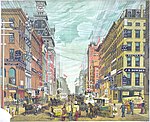Thurgood Marshall College Fund
1987 establishments in Washington, D.C.501(c)(3) organizationsHistorically black universities and colleges in the United StatesScholarships in the United StatesUniversity stubs
The Thurgood Marshall College Fund (TMCF) is an American non-profit organization that supports and represents nearly 300,000 students attending its 47 member-schools that include public historically black colleges and universities (HBCUs), medical schools, and law schools. The organization is named after the Supreme Court's first African-American Justice, Thurgood Marshall.
Excerpt from the Wikipedia article Thurgood Marshall College Fund (License: CC BY-SA 3.0, Authors).Thurgood Marshall College Fund
Liberty Street, New York Manhattan
Geographical coordinates (GPS) Address Nearby Places Show on map
Geographical coordinates (GPS)
| Latitude | Longitude |
|---|---|
| N 40.707295 ° | E -74.007584 ° |
Address
Liberty Plaza Garage
Liberty Street
10005 New York, Manhattan
New York, United States
Open on Google Maps









